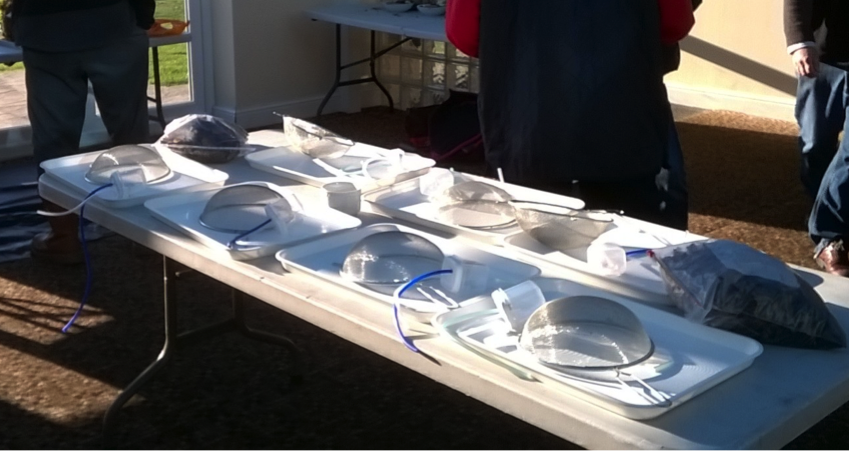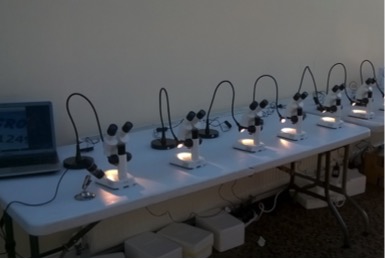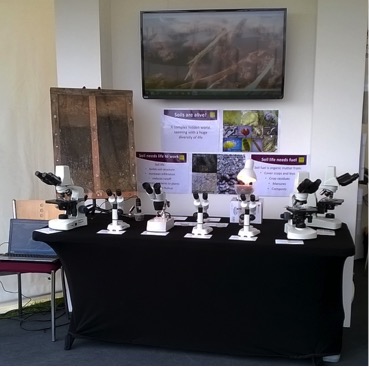Download the guide to mesofauna identification & ‘pootering’ help sheet
Other documents that may help: Soil mite guide & Simple kids key to soil organisms
Soils, including litter layers, provide a habitat for a wide range of soil organisms. Organisms that are visible to the naked eye, but which can fit through a 2mm hole are called “mesofauna”, smaller animals are micro-organisms (needing a microscope to view), and larger ones are macro-fauna. Soil mesofauna are the most abundant visible organisms in most terrestrial ecosystems, and are dominated by mites, springtails, insects, other hexapods and smaller oligochaete worms. Sieving is a good way to collect and observe these hidden organisms which provide a good introduction to the diversity of life in the soil, and can help us to understand how the soil and overlying leaf litter can provide a home for numerous animals with different useful roles in the soil.
Learning objectives:
- Understand that soils are homes to a wide diversity of living organisms
- Understand how to collect and observe soil mesofauna.
- Use a picture guide to identify likely predators and decomposers in the soil community
- Look at how the behaviour and movement of organisms reflect their roles in the soil ecosystem.
Equipment:
- Freshly-collected leaf litter and topsoil – collected from under a broadleaved tree or other suitable habitat.
- Trowel for collecting leaf litter/ soil
- Gardening gloves
- Clingfilm
- Two buckets
- Disposable nitryl gloves.
- For pooters:
- Small 100ml plastic food-saver pots (1 per learner) with two 5mm holes drilled in the top
- Electric drill with 6mm bit
- DIY dust masks
- Blue and clear plastic 6mm tubes tubes (from fish tank / aquarist areas in pet shops)
- Small rubber bands
- Scissors
- Small sticky paper labels for pooters
- Narrow plastic straws.
- Small bin or tub for used straws.
- White plastic trays one per learner/pair
- Standard Kitchen Sieve (one per learner/pair)
- Small 5cm diameter plastic peitri dishes with clear lids.
- Microscopes (USB or binocular dissecting microscope with top lighting)
- Lamps (if needed) for lighting up microscope specimens.
- Printed/laminated pictorial identification guide (see appendix).
- Extension – kitchen towel or plaster of paris with charcoal.
Preparation:
Collect soil and litter in advance, by placing a bucket on its side in the leaf litter and, wearing gardening gloves, use a trowel to push/scrape the topsoil into the bucket. Once full, cover the bucket with cling film until needed to deter creatures from escaping and prevent the litter drying out.
Pooters can be prepared in advance and reused, or made as part of the activity for the learners to keep. Either way, prepare by using the drill to make 2 holes in the lid of the airtight small (100ml) plastic “food saver” pot. Holes should be 1 mm diameter smaller than the diameter of the tubing used. To assemble the pooters cut a 40 cm length of blue tube and a 20 cm length of clear tube and insert both through the holes. Cut out a 3 cm diameter circle from the dust mask, and where the blue tube pokes through under the lid, wrap the circle of material over the end of the tube and secure in position by looping a rubber band around it several times. Fix the lid with the tubes onto the pot. Animals are captured by sucking on the blue tube while holding the end of the pooter next to the animal to be captured. The suction will draw the animal into the pot and the filter will prevent it being drawn into the user’s mouth.
Lay out one tray, one sieve and one petri dish for each learner, and set up low magnification x10 or x20 microscopes with lights. You can also arrange this activity as a series of stations, where learners move from the sieving area to the petri dishes, to the the microscopy area, which helps to keep the microscope area cleaner. Set up one bucket for disposal of “spent” leaf litter and soil.


Time required:
Allow 10 minutes for building a pooter if not using pre-prepared pooters. Allow 10 minutes for sieving and pooter collecting of soil mesofauna. Allow 15 minutes for examination of the soil fauna captured. Extension: 1 afternoon to 1 day depending on effort.
Risk assessment – please read and adapt:
| Hazard | Likelihood | Severity | Mitigation |
| Disease from soil | Low | High | Ensure participants have Tetanus jabs, wear gloves if there are cuts on hands, advise participants to avoid contact between hands and mouth, eyes, nose etc. |
| Choking hazard from misuse of pooters. | Med | High | Check that each pooter has been constructed properly with filter on blue tube present and well secured. Ensure everyone is paying attention regarind the B for Blue B for Breathing safety talk. |
| Disease or respiratory problems from pooter use | Low | Medium/high | Ensure pooters are properly constructed, and tell participants understand to suck into mouth (opening of jaw motion), rather than into lungs. Ask participants if they have any respiratory problems or susceptibilities and supply these people with a pippette filler or similar hand-held device (https://www.coleparmer.com/i/cole-parmer-valved-pipette-aspirator-bulb-filler-50-ml-capacity/2480510) |
| Eye strain, muscle strain from working at microscopes. | Low | Low | People will not spend long at microscopes for this excercise, but encourage people to adopt a comfortable position and adjust microscopes correctly. |
| Ticks | Low | High | There is a small chance that there will be ticks in the leaf litter, which may attach to participants, and may spread serious diseases. Try to collect leaf litter from areas away from high deer populations, and encourage participants to wear gloves and to shake off any residue from their gloves after the excercise. If you suspect ticks may be present, ask learners to check themselves and report back to you. |
| Spread of disease between students via pooters | Medium | Low | It is possible that learners may mix up their pooters with each other, or catch germs from pooters used by previous learners. This risk can be minimised by ensuring that people label their pooters with their name, and by askig them to use disposable plastic straws, inserted into the blue tube, to suck through. |
Description of activities:
- Explain the context of the activity – what soil mesofauna are, how there are predators, herbivores and decomposers, and that they live in the topsoil and leaf litter.
- Explain and demonstrate the
actvitiy (see actions below) emphasising the importance of
- wearing gloves to handle the litter/soil
- sucking through the blue tube only: B for blue, B for breathing
- inserting a disposable straw into the blue tube to suck through
- Sucking with the mouth, not lungs (using an opening of the jaw to generate suction
- Brushing off any litter etc from their equipment, glove etc into the waste bin provided.
- Each learner collects a handful of leaf litter/soil mix and puts it in their sieve, then bounces it up and down gently over the tray. Small animals and other small detritus will fall thorugh onto the tray.
- Learners look at the tray for tiny moving animals, some of which may only just be visible to the naked eye. Some may also be very slow moving, or move rapidly.
- Where they see an animal moving, they should place the clear tube of the pooter next to the animal (not on top of it) and suck on the straw in the blue tube briefly to suck the animal into the collection pot.
- Keep collecting animals for about 5-10 minutes, collecting more leaf litter if needed.
- Once finished, tip used litter and brush off sieves and gloves into the waste bucket.
- To transfer the animals form the pooter to the petri dish, get a petri dish, and remove the lid and place it nearby. Tap the pooter sharply on a hard surface, holding it at an angle so that animals are knocked into a corner. Quickly remove the lid and tip the animals into the petri dish, tapping the base of the pooter pot as you do so. Very quickly replace the petri dish lid. These animals will jump!
- Place the petri dish on the stage of a dissecting low-magnificaiton microscope. Observe the range of shapes, sizes, colours, and modes of movement of the different animals you’ve collected.
- Use the pictorial guide provided here to find similar shaped animals. How many are decomposers? How many are predators? Do the predators move differently to the decomposers? Why? What defences do the decomposers have that help them avoid predation?
Extension activity: Create a soil zoo display
Prepare some petri dishes with discs of moist kitchen towel at the base, or mix plaster of paris with powdered charcoal, allow to set in the bottom of a petri dish and moisten. Separate out the predators and decomposers into different groups and try to provide the with food to maintain them for a few days. Decomposers may be interested in tiny shavings of carrot, tiny pieces of rotting litter or soggy rotting wood, tiny shreds of mushroom, active yeast granules, or spirulina powder. Try several different types of food to see what they prefer. Predators may need a supply of live springtails to keep them busy and prevent them eating each other. Research some facts about each group, and create some information cards for the display. Consider setting up the display for an open evening, science show or other event and invite people to look down microscopes at the creatures you’ve captured.

Interpretation:
A simple photographic guide key is provided.
Discuss your observations in the context of the following information.
Predators are often fast moving and constantly active, and/or are equipped with large mouthparts or eg. pincers for attack. Decomposers tend to be slower moving, but may move fast in escape, and have smaller mouthparts. Decomposers often have defence mechanisms – many Springtails are equipped with a jumping organ (called a furca) that can fling them away to safety. Others such as slow moving mites may be well armoured (dark and shiny) or have very long hairs, or even piles of dirt or old shed skins as their defences. Some (usually white) soil dwelling springtails have no visible defences but have poisonous glands to repel attackers.
Decomposers release nutrients into the soil in forms that are more accessible to plants and therefore support growth of crops etc. They also help to dispose of organic waste and their dung becomes humus which stores soil water and nutrients. Predators also recycle nutrients but also have the additional benefit of controlling pests. Where the soil supports abundant predators, numbers of pests such as root-feeding nematodes are controlled.